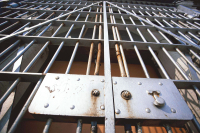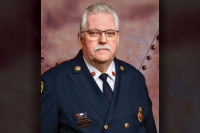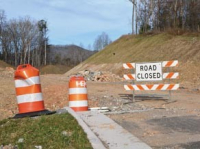Haywood Tree to serve as Capitol Christmas tree, prompt spruce restoration efforts

Sometime around 1940, a red spruce seedling pushed above the forest floor in southern Haywood County. Its roots drank from the moist soil, and each year the tree grew taller and stronger.
The nearby logging road was eventually paved, widened, and christened N.C. 215. Increasing numbers of cars climbed it each year, especially after the ridgetop road just uphill, the Blue Ridge Parkway, was completed. As the decades ticked by, the number of cars roaring through the tree’s neighborhood reached into the millions. Eventually, their drivers could see the treetop from the road, towering over the rest of the trees in the forest.
Last week, the tree — named Ruby — began its own journey along the road over which it has long stood sentry. In a ceremony Wednesday, Nov. 2, it was cut down and loaded into a trailer destined for Washington, D.C., where Ruby will soon decorate the West Lawn of the U.S. Capitol Building as this year’s Capitol Christmas Tree.

- The tree was harvested by Rodney Smith, a 30-year employee of the Uwharrie National Forest with support from Dover Crane and Bartlett Tree Experts.
“Over this past year, we combed the mountainsides of the Pisgah and the Nantahala National Forest looking for just the right tree, and we think Ruby is just that,” Lorie Stroup, U.S. Capitol Christmas Tree Coordinator, said during the harvest ceremony. “Along with that we conducted over 100 conservation education outreach events across the state, and our work will continue for years to come with our red spruce restoration efforts.”
Each year, one of the country’s national forests supplies the towering tree that serves as a national symbol of celebration on the West Lawn. For the first time since 1998 — and the third time in history — that tree comes from the Pisgah-Nantahala National Forest.
Related Items
It’s also the third time in history that a red spruce will adorn the West Lawn, and the first time a red spruce will come from the Pisgah-Nantahala.
“The red spruce is an iconic tree species in Southern Appalachia,” Pisgah-Nantahala Forest Supervisor James Melonas said during the ceremony.
The future of red spruce
The high-elevation spruce-fir forests where red spruce grow are among the region’s most imperiled ecosystems, prompting the Forest Service to intertwine restoration efforts with the tree harvest. While the 78-foot tree no longer towers above the canopy along N.C. 215, its cones have been gathered into a paper grocery bag that now resides at the Southern Highlands Reserve, a cultivator of native plants in Lake Toxaway that specializes in producing red spruce seedlings.
“It’s something that I never thought I would do in my career,” said Executive Director Kelly Holdbrooks. “It’s kind of a once-in-a-lifetime experience. I’m honored to be part of it.”
Holdbrooks and her staff became accidental experts on propagating red spruce, a notoriously difficult tree to produce. Young red spruce trees are more sensitive to environmental stressors than mature trees, but the Southern Highlands Reserve developed methods to effectively grow and transplant these trees that result in a 90% success rate — something that’s “really unheard of in reforestation efforts,” said Southern Highlands Reserve’s communications director Holly Renehan.

- Coche Tiger tells the Cherokee legend of the evergreen trees as EBCI Secretary of Agriculture and Natural Resources Joey Owle looks on.
Initially, the Reserve was just growing seedlings for use in their own gardens, but a chance meeting with a wildlife biologist resulted in a partnership with The Nature Conservancy to produce more trees for restoration projects. Increasing the viability and size of these spruce-fir islands in the sky, as well as restoring their connectivity to one another, means a better chance of survival for the forests and all species that inhabit them.
In 2015, that partnership expanded to include various state, federal, nonprofit and university organizations and was named the Southern Appalachian Spruce Restoration Initiative. Now, Southern Highlands Reserve is now working to fulfill the Forest Service’s request for 50,000 red spruce trees. So far they’ve grown about 10,000, with 6,000 planted on public land in North Carolina, Tennessee and Virginia thus far.
That’s a lot of trees, and they’ve produced them all using a pair of 20-year-old hoop houses.
But a higher-tech future is on the horizon. With Ruby’s harvest, the Forest Service announced $250,000 in funding toward a new greenhouse to be managed by Southern Highlands Reserve. The 1,800-square-foot facility will nearly triple the Reserve’s current nursery space and incorporate technology to help staff better care for the young trees.
“If we’re able to produce 2,000 seedlings a year with those (old hoop houses), the sky’s the limit with what we’re going to be able to do with state-of-the- art technology,” Holdbrooks said.
The overall project will cost about $1 million, with the Forest Service committing $50,000 and the National Forest Foundation raising $200,000 more. Holdbrooks expects to break ground in 2024, with supply chain issues likely to be the main obstacle to getting started. Manufacturing the greenhouse pieces will take six to eight months.
It’s a long-term project, but so is growing trees. The shortage of spruce-fir forest in today’s Southern Appalachians is the result of forces acting for decades before Ruby first sprouted as a seedling. First there was the frenzy of logging in the late 1800s and early 1900s, accompanied by construction of railroads through the rugged terrain. There were hot-burning wildfires, then torrential rains that swept away the charred soil, eliminating any seeds that may have been stored there. The balsam wooly adelgid killed off swaths of balsam trees, and mid-century air pollution damaged the already fragile environment.
“I am happy to report that the red spruce is the least in decline of the conifers, so it’s our best hope, and that’s why we’re planting red spruce back on the land,” Holdbrooks said.

- An enormous crane was required to safely harvest Ruby.
‘For future generations’
Ruby is on tour now, making stops throughout North Carolina and Virginia as she heads toward her scheduled Nov. 18 delivery to the West Lawn in D.C. on a specially decaled Kenworth T680.
Accompanying her to D.C. will be 80 smaller trees from Christmas tree farms across the state, many of which will be delivered to military families at the Andrews Air Force Base. The Forest Service doubled its goal of 6,000 donated, handmade ornaments to decorate the trees. After Christmas is over, Ruby’s wood will be used to make musical instruments.
When it’s time to light the tree for the Christmas season, fourth grader Coche Tiger, a student at New Kituwah Academy in Cherokee, will do the honors. He was chosen through an application process that included a question about the environment and his Cherokee culture.
Though he’s only 9, Tiger is well aware of the ancient stories his people tell about how the trees that cover our mountains came to be. During the Nov. 2 ceremony, he told the Cherokee legend of the evergreen tree. In the story, when they were created all the trees and animals were asked to stay awake for seven nights, fasting and praying, but as each night passed, a few more fall asleep. By the seventh night, only a few remained awake. The animals that persevered to the end were given the power to see and go about in the dark. The trees — spruce, pine, cedar, holly hemlock and laurel — were given the ability to keep their leaves all year and to give provide medicine to the Cherokee people.
“Therefore, these trees are sacred and used for medicine by the Cherokee people,” Tiger said.
Towering to 78 feet, Ruby had about 12 inches of height for each year of life. Story, history, and the passing of time are all bound up in the presence of a large, old tree like her. But to plant a spruce seed is to believe in the future.
“When you plant forests and when you plant trees, you’re planting those for generations behind you,” said Holdbrooks. “I think that’s the message I want people to understand. When you’re doing this kind of work, you’re doing it for future generations.”
Track the tree
For more information about the Capitol Christmas Tree, including scheduled stops and a tree tracking feature, visit uscapitolchristmastree.com. Video of the harvest ceremony is available at facebook.com/uscapitolchristmastree.

- After the harvest ceremony, Ruby makes her way down N.C. 215, ultimately destined for Washington, D.C. After the harvest ceremony, Ruby makes her way down N.C. 215, ultimately destined for Washington, D.C. James Edward Mills/Choose Outdoors photos













